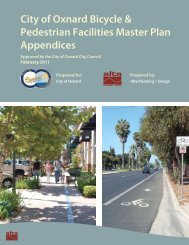View File - Development Services - City of Oxnard
View File - Development Services - City of Oxnard
View File - Development Services - City of Oxnard
Create successful ePaper yourself
Turn your PDF publications into a flip-book with our unique Google optimized e-Paper software.
WATER RESOURCES TECHNICAL REPORTSelect water quality objectives for these groundwaters are as follows from the Basin Plan:RWQCB Basin Plan Objectives for Groundwater<strong>Oxnard</strong> PlainWater Quality Objectives(mg/L)Groundwater Basin TDS Sulfate Chloride Boron• <strong>Oxnard</strong> Forebay 1,200 600 150 1.0• Confined aquifers 1,200 600 150 1.0• Unconfined perched aquifers 3,000 1,000 500 --Pleasant Valley• Confined aquifers 700 300 150 1.0• Unconfined perched aquifers -- -- -- --As noted above, the water quality is naturally poor in the Semi-Perched zone and is notcommonly used for potable supply, even though it is designated as MUN. The water qualityin the Semi-Perched Aquifer is further discussed below.Areas <strong>of</strong> degraded water quality exist and are <strong>of</strong> great concern given the reliance <strong>of</strong> thearea on groundwater as a primary water resource. The primary water quality concern isdegradation resulting from overdraft conditions. In addition, water quality is also degradeddue to nitrates that occur in the Forebay area from agricultural activities and from potentialconstituents from former and current gasoline storage and dispensing facilities. Each <strong>of</strong> thesources <strong>of</strong> poor water quality is discussed below.Water Quality in the Semi-Perched AquiferAs noted above, the water quality in the Semi-Perched Aquifer can vary widely with timeand location, ranging from fresh to brackish. Nutrients and other dissolved constituents inagricultural irrigation return flows contribute to the poor water quality <strong>of</strong> perched water.The primary concern <strong>of</strong> water quality is from potential cross contamination <strong>of</strong> the perchedwater to the deeper confined aquifer units. Limited data suggest that semi-perched waterlevels fluctuate little on the <strong>Oxnard</strong> Plain and <strong>of</strong>ten occur within 5 to 10 feet <strong>of</strong> groundsurface. Perched water will percolate downward to the deeper, confined aquifers throughfine-grained sediments and potentially through improperly constructed wells when thewater levels in the deeper aquifers are depressed.Water Quality from Overdraft ConditionsHistorical and current overdraft conditions have led to areas <strong>of</strong> degraded water qualitycharacterized by elevated chloride and TDS concentrations typically associated with salinewaters. These saline waters from overdraft conditions are the principal water qualityconcern in the <strong>Oxnard</strong> Plain and Pleasant Valley areas. The USGS RASA Program hasprovided data to assess the sources and extent <strong>of</strong> these elevated chlorides. This has includedregularly collecting and analyzing samples from the series <strong>of</strong> RASA coastal monitoringwells shown in Figure 2-9. As summarized in the 2002 Coastal Saline Intrusion Report(UWCD, 2003), four types <strong>of</strong> chloride degradation have been documented:• Lateral Seawater Intrusion. The inland movement <strong>of</strong> seawater at the near-shore Muguand Hueneme submarine canyons intersect the aquifers <strong>of</strong> the UAS and LAS a shortW112003002SCO LW1458.DOC/ 033390002 24
















